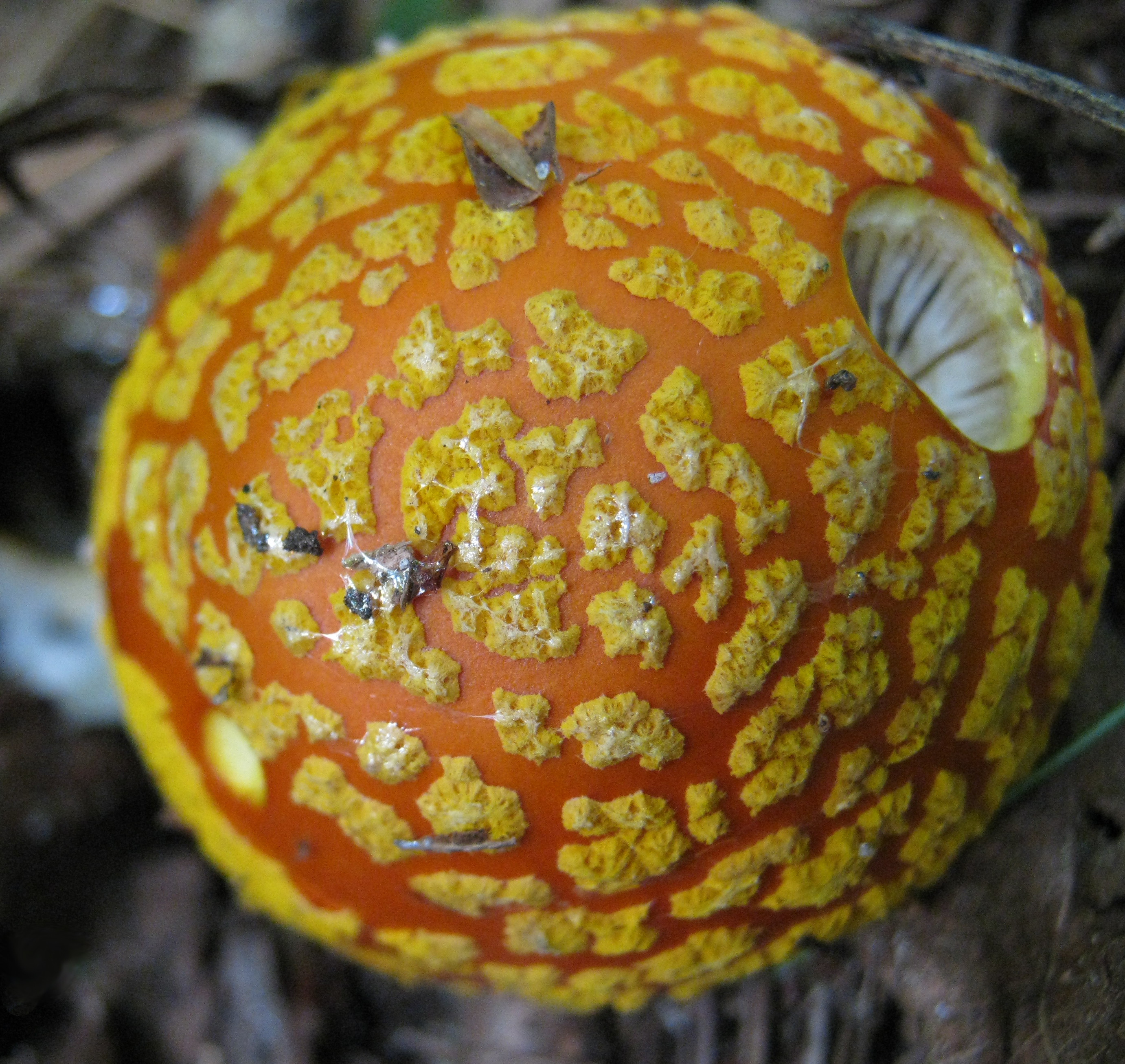List Of Amanita Species on:
[Wikipedia]
[Google]
[Amazon]
The following is a list of some notable species of the
 *
* ''
'' '' Amanita aliena'' – (south Brazil)
*
'' Amanita aliena'' – (south Brazil)
* ''
'' '' Amanita aprica'' – (North America)
*
'' Amanita aprica'' – (North America)
* '' Amanita armeniaca'' – gypsy amanita (Australia)
*
'' Amanita armeniaca'' – gypsy amanita (Australia)
* '' Amanita augusta'' – USA
*
'' Amanita augusta'' – USA
* ''
'' ''
'' '' Amanita eliae'' – (Europe)
*
'' Amanita eliae'' – (Europe)
* ''
'' ''
'' ''
'' '' Amanita ibotengutake'' – Japanese Ringed-Bulb Amanita (Japan)
*
'' Amanita ibotengutake'' – Japanese Ringed-Bulb Amanita (Japan)
* ''
'' '' Amanita multisquamosa'' - Small Funnel-Veil Amanita (eastern North America)
*
'' Amanita multisquamosa'' - Small Funnel-Veil Amanita (eastern North America)
* '' Amanita nehuta'' – Maori dust Amanita (New Zealand)
*
'' Amanita nehuta'' – Maori dust Amanita (New Zealand)
* '' Amanita parcivolvata'' – False Caesar, False Fly Agaric
*
'' Amanita parcivolvata'' – False Caesar, False Fly Agaric
* ''
'' '' Amanita parvipantherina'' – (Yunnan province, southwestern China)
*
'' Amanita parvipantherina'' – (Yunnan province, southwestern China)
* ''
'' '' Amanita petalinivolva'' – (Brazil)
*
'' Amanita petalinivolva'' – (Brazil)
* ''
'' '' Amanita roseotincta'' – North America
*
'' Amanita roseotincta'' – North America
* ''
'' '' Amanita velatipes'' – (eastern North America)
*
'' Amanita velatipes'' – (eastern North America)
* '' Amanita virgineoides'' – white-colored (Japan)
*
'' Amanita virgineoides'' – white-colored (Japan)
* '' Amanita viscidolutea'' – (Brazil)
*
'' Amanita viscidolutea'' – (Brazil)
* '' Amanita wellsii'' – salmon amanita (North America)
*
'' Amanita wellsii'' – salmon amanita (North America)
* '' Amanita xanthocephala'' – vermillion grisette (Australia)
'' Amanita xanthocephala'' – vermillion grisette (Australia)
 *
* '' Amanita argentea'' (=''Amanita mairei'') – (Europe)
*
'' Amanita argentea'' (=''Amanita mairei'') – (Europe)
* '' Amanita battarrae'' (=''Amanita umbrinolutea'') – umber-zoned ringless amanita (Europe)
*
'' Amanita battarrae'' (=''Amanita umbrinolutea'') – umber-zoned ringless amanita (Europe)
* ''
'' ''
'' ''
'' ''
'' '' Amanita groenlandica'' – (Greenland and Northern Europe)
*
'' Amanita groenlandica'' – (Greenland and Northern Europe)
* '' Amanita liquii'' – (southwestern China)
*
'' Amanita liquii'' – (southwestern China)
* '' Amanita lividopallescens'' – (Europe)
*
'' Amanita lividopallescens'' – (Europe)
* ''
'' '' Amanita orientifulva'' – (southwestern China)
*
'' Amanita orientifulva'' – (southwestern China)
* ''
'' '' Amanita pekeoides'' – Maori's sack ringless Amanita (New Zealand)
*
'' Amanita pekeoides'' – Maori's sack ringless Amanita (New Zealand)
* ''
'' '' Amanita submembranacea'' – (Europe)
*
'' Amanita submembranacea'' – (Europe)
* ''
'' '' Amanita velosa'' – springtime amanita, coral to peachy pink ringless amanita (western North America)
'' Amanita velosa'' – springtime amanita, coral to peachy pink ringless amanita (western North America)
 *
* '' Amanita arkansana'' – (USA)
*
'' Amanita arkansana'' – (USA)
* ''
'' ''
'' '' Amanita caesareoides '' – Asian Vermilion Slender Caesar (South-East Asia)
*
'' Amanita caesareoides '' – Asian Vermilion Slender Caesar (South-East Asia)
* ''
'' '' Amanita hemibapha'' (species complex) – half-dyed slender Caesar (Pantropical)
*
'' Amanita hemibapha'' (species complex) – half-dyed slender Caesar (Pantropical)
* '' Amanita kitamagotake'' – Becker's ringless amanita (Japan)
*
'' Amanita kitamagotake'' – Becker's ringless amanita (Japan)
* ''
'' ''
'' ''
'' '' Amanita spreta'' – hated amanita, hated Caesar (eastern North America)
*
'' Amanita spreta'' – hated amanita, hated Caesar (eastern North America)
* '' Amanita zambiana'' – Zambian slender Caesar (Africa)
'' Amanita zambiana'' – Zambian slender Caesar (Africa)
 *
* '' Amanita arocheae'' – Latin American death cap (Central/South America)
*
'' Amanita arocheae'' – Latin American death cap (Central/South America)
* ''
'' '' Amanita exitialis'' – Guangzhou destroying angel (southern China)
*
'' Amanita exitialis'' – Guangzhou destroying angel (southern China)
* '' Amanita fuliginea'' - East Asian Brown Death Cap (Japan, China)
*
'' Amanita fuliginea'' - East Asian Brown Death Cap (Japan, China)
* '' Amanita hesleri '' – Hesler's Lepidella (eastern North America)
*
'' Amanita hesleri '' – Hesler's Lepidella (eastern North America)
* ''
'' '' Amanita magnivelaris'' – great felt skirt destroying angel (eastern North America)
*
'' Amanita magnivelaris'' – great felt skirt destroying angel (eastern North America)
* '' Amanita manginiana'' – Chiu's false death cap (East Asia)
*
'' Amanita manginiana'' – Chiu's false death cap (East Asia)
* '' Amanita marmorata subsp. myrtacearum'' – marbled death cap (Hawaii)
*
'' Amanita marmorata subsp. myrtacearum'' – marbled death cap (Hawaii)
* ''
'' ''
'' '' Amanita pseudoporphyria'' – Hongo's false death cap (East & South Asia)
*
'' Amanita pseudoporphyria'' – Hongo's false death cap (East & South Asia)
* ''
'' ''
'' '' Amanita virosa'' – destroying angel (Europe)
*
'' Amanita virosa'' – destroying angel (Europe)
* '' Amanita virosiformis'' – narrow-spored destroying angel (Florida)
*
'' Amanita virosiformis'' – narrow-spored destroying angel (Florida)
* '' Amanita volvarielloides'' – (Australia)
'' Amanita volvarielloides'' – (Australia)
 *
* '' Amanita aestivalis'' - white American star-footed Amanita (North America)
*
'' Amanita aestivalis'' - white American star-footed Amanita (North America)
* '' Amanita australis'' - far south Amanita (New Zealand)
*
'' Amanita australis'' - far south Amanita (New Zealand)
* ''
'' '' Amanita brunneolocularis'' - Mesoamerican Dark Volva Blusher (Colombia, Costa Rica, Honduras)
*
'' Amanita brunneolocularis'' - Mesoamerican Dark Volva Blusher (Colombia, Costa Rica, Honduras)
* ''
'' ''
'' ''
'' ''
'' '' Amanita flavella'' – orange Amanita, Australian yellow-dust amanita (Australia)
*
'' Amanita flavella'' – orange Amanita, Australian yellow-dust amanita (Australia)
* ''
'' '' Amanita flavorubens'' – yellow blusher (eastern North America)
*
'' Amanita flavorubens'' – yellow blusher (eastern North America)
* '' Amanita franchetii'' (= ''Amanita aspera'') – yellow-veiled amanita (Europe, North America)
*
'' Amanita franchetii'' (= ''Amanita aspera'') – yellow-veiled amanita (Europe, North America)
* ''
'' '' Amanita nothofagi'' - southern beech Amanita (New Zealand)
*
'' Amanita nothofagi'' - southern beech Amanita (New Zealand)
* '' Amanita novinupta'' – western blusher, blushing bride (western North America)
*
'' Amanita novinupta'' – western blusher, blushing bride (western North America)
* ''
'' ''
'' '' Amanita solaniolens'' – old potato amanita (Nova Scotia, Canada)
'' Amanita solaniolens'' – old potato amanita (Nova Scotia, Canada)
 *
* ''
'' ''
'' '' Amanita austroviridis'' (Australia) – Australian verdigris Lepidella
*
'' Amanita austroviridis'' (Australia) – Australian verdigris Lepidella
* '' Amanita ananaeceps'' – White-veiled Lepidella, Australian pineapple Lepidella (Australia)
*
'' Amanita ananaeceps'' – White-veiled Lepidella, Australian pineapple Lepidella (Australia)
* '' Amanita cinereovelata'' – northern Bangladesh
*
'' Amanita cinereovelata'' – northern Bangladesh
* ''
'' '' Amanita daucipes'' – Carrot-foot Lepidella, turnip-foot Amanita
*
'' Amanita daucipes'' – Carrot-foot Lepidella, turnip-foot Amanita
* '' Amanita macrocarpa'' – South China
*
'' Amanita macrocarpa'' – South China
* '' Amanita magniverrucata'' – Great-warted Lepidella
*
'' Amanita magniverrucata'' – Great-warted Lepidella
* '' Amanita neo-ovoidea'' – (Asia)
*
'' Amanita neo-ovoidea'' – (Asia)
* ''
'' '' Amanita ovoidea'' – bearded amanita, European egg amidella (southern Europe)
*
'' Amanita ovoidea'' – bearded amanita, European egg amidella (southern Europe)
* '' Amanita ravenelii'' – (North America) Pinecone Lepidella
*
'' Amanita ravenelii'' – (North America) Pinecone Lepidella
* '' Amanita rhopalopus'' – (North America) American Club-Footed Lepidella
*
'' Amanita rhopalopus'' – (North America) American Club-Footed Lepidella
* ''
'' ''
'' ''
'' ''
''
 ''
'' '' Amanita curtipes'' – (southern Europe)
*
'' Amanita curtipes'' – (southern Europe)
* '' Amanita gilbertii'' – (France & Germany)
*
'' Amanita gilbertii'' – (France & Germany)
* ''
'' '' Amanita ponderosa'' – (southern Europe)
*
'' Amanita ponderosa'' – (southern Europe)
* '' Amanita proxima'' – (southern Europe)
*
'' Amanita proxima'' – (southern Europe)
* '' Amanita volvata'' * – American amidella (eastern North America)
'' Amanita volvata'' * – American amidella (eastern North America)
 ''
'' '' Amanita inopinata'' – Unexpected Guest Lepidella (New Zealand, western Europe)
*
'' Amanita inopinata'' – Unexpected Guest Lepidella (New Zealand, western Europe)
* '' Amanita lesueurii'' - Lesueur's Lepidella (southwestern Australia)
*
'' Amanita lesueurii'' - Lesueur's Lepidella (southwestern Australia)
* '' Amanita nauseosa''
*
'' Amanita nauseosa''
* ''
'' ''
''
Recommended English Names for Fungi in the UK
* Lincoff GH. (1981). The Audubon Society field guide to North American mushrooms. New York: Alfred A. Knopf. * Tulloss RE. (2007)
"The genus ''Amanita'' Pers. (Agaricales, Fungi)"
(website) {{commons category, Amanita *
agaric
An agaric () is a type of fungus fruiting body characterized by the presence of a pileus (cap) that is clearly differentiated from the stipe (stalk), with lamellae (gills) on the underside of the pileus. In the UK, agarics are called "mushrooms ...
genus ''Amanita
The genus ''Amanita'' contains about 600 species of agarics, including some of the most toxic known mushrooms found worldwide, as well as some well-regarded edible species. This genus is responsible for approximately 95% of the fatalities result ...
''. This genus contains over 500 named species and varieties, but the list is far from exhaustive. The list follows the classification of subgenera and sections of ''Amanita'' outline by Corner and Bas; Bas, as used by Tulloss (2007) and modified by Redhead & al. (2016) for ''Amanita'' subgenus ''Amanitina'' and Singer for ''Amanita'' section ''Roanokenses''. Bolding of the species name and an asterisk (*) following indicates the species is the type species
In zoological nomenclature, a type species (''species typica'') is the species name with which the name of a genus or subgenus is considered to be permanently taxonomically associated, i.e., the species that contains the biological type specimen ...
of that section, with a double asterisk (**) indicating the type species of the entire genus. The use of common names follows Tulloss (2007), Holden (2003), Arora (1986), and Lincoff (1981).
Subgenus ''Amanita''
Section ''Amanita''
 *
* ''
''Amanita albocreata
''Amanita albocreata'', also called the ringless panther or the ringless panther amanita, is a species of fungus in the family Amanitaceae. It was discovered in 1944, by William Murrill. It is commonly found in northeastern United States and sou ...
'' – (North America)
* '' Amanita aliena'' – (south Brazil)
*
'' Amanita aliena'' – (south Brazil)
* ''
''Amanita altipes
''Amanita altipes'', also called the yellow long-stem amanita, is a species of agaric fungus found in coniferous woodlands in southwestern China.
Description
''Amanita altipes'' is a small to medium-sized agaric with a distinctively yellowis ...
'' – (southwestern China)
* '' Amanita aprica'' – (North America)
*
'' Amanita aprica'' – (North America)
* '' Amanita armeniaca'' – gypsy amanita (Australia)
*
'' Amanita armeniaca'' – gypsy amanita (Australia)
* '' Amanita augusta'' – USA
*
'' Amanita augusta'' – USA
* ''
''Amanita breckonii
''Amanita breckonii'' is a species of agaric fungus in the genus ''Amanita''. It is known from California and Washington (state), Washington, where it associates with Monterey pine, ponderosa pine, and spruce. The species was species description, ...
'' – western USA
* ''
''Amanita chrysoblema
''Amanita chrysoblema'', with the common name American fly agaric, white variant, is a basidiomycete fungus of the genus ''Amanita''. Although named ''chrysoblema'', it is traditionally thought to be an '' Amanita muscaria'' variant, a group of f ...
''
* '' Amanita eliae'' – (Europe)
*
'' Amanita eliae'' – (Europe)
* ''
''Amanita farinosa
''Amanita farinosa'', commonly known as the Eastern American floury amanita or the American floury amanita, is a North American poisonous mushroom of the genus ''Amanita'', a genus of fungi including some of the most deadly mushrooms.
Taxonomy ...
'' – (eastern North America to Central America)
* ''
''Amanita frostiana
''Amanita frostiana'', also known as Frost's amanita, is a small fungus species of eastern U.S. and southeastern Canada. The mushroom varies in colours from yellow, red or reddish pink usually.
Description
Some of the species' notable physic ...
'' – Frost's amanita (eastern North America)
* ''
''Amanita gemmata
''Amanita gemmata'', commonly known as the gemmed amanita or the jonquil amanita, is an agaric mushroom of the family Amanitaceae and genus ''Amanita''. The fruit body has a cap that is a dull to golden shade of yellow, and typically in di ...
'' – gemmed mushroom, jewelled amanita (Europe)
* '' Amanita ibotengutake'' – Japanese Ringed-Bulb Amanita (Japan)
*
'' Amanita ibotengutake'' – Japanese Ringed-Bulb Amanita (Japan)
* ''
''Amanita muscaria
''Amanita muscaria'', commonly known as the fly agaric or fly amanita, is a basidiomycete of the genus ''Amanita''. It is also a muscimol mushroom. Native throughout the temperate and boreal regions of the Northern Hemisphere, ''Amanita muscar ...
'' ** – fly agaric (cosmopolitan)
* '' Amanita multisquamosa'' - Small Funnel-Veil Amanita (eastern North America)
*
'' Amanita multisquamosa'' - Small Funnel-Veil Amanita (eastern North America)
* '' Amanita nehuta'' – Maori dust Amanita (New Zealand)
*
'' Amanita nehuta'' – Maori dust Amanita (New Zealand)
* '' Amanita parcivolvata'' – False Caesar, False Fly Agaric
*
'' Amanita parcivolvata'' – False Caesar, False Fly Agaric
* ''
''Amanita pantherina
''Amanita pantherina'', also known as the panther cap, false blusher, and the panther amanita due to its similarity to the true blusher ('' Amanita rubescens''), is a species of fungus found in Europe and Western Asia.
Description
*Cap: 5� ...
'' – panther mushroom, panther cap (Northern Hemisphere)
* '' Amanita parvipantherina'' – (Yunnan province, southwestern China)
*
'' Amanita parvipantherina'' – (Yunnan province, southwestern China)
* ''
''Amanita persicina
''Amanita persicina'', commonly known as the peach-colored fly agaric, is a basidiomycete fungus of the genus ''Amanita''. This fungus was previously believed to be a variety of ''Amanita muscaria'', but research has recently shown that ''Amanit ...
'' – Peach-Colored Fly Agaric
* '' Amanita petalinivolva'' – (Brazil)
*
'' Amanita petalinivolva'' – (Brazil)
* ''
''Amanita regalis
''Amanita regalis'', commonly known as the royal fly agaric or the king of Sweden Amanita, is a species of fungus in the family Amanitaceae. Common in Scandinavian countries, it is also found in eastern and northern Europe. In North America, ...
'' – royal fly agaric (Europe, Alaska)
* '' Amanita roseotincta'' – North America
*
'' Amanita roseotincta'' – North America
* ''
''Amanita rubrovolvata
''Amanita rubrovolvata'', commonly known as the red volva amanita, is a species of fungus in the family Amanitaceae. The fungus produces small to medium-sized mushrooms, with reddish-orange caps up to wide. The stems are up to tall, cream-c ...
'' – red volva amanita (Asia)
* '' Amanita velatipes'' – (eastern North America)
*
'' Amanita velatipes'' – (eastern North America)
* '' Amanita virgineoides'' – white-colored (Japan)
*
'' Amanita virgineoides'' – white-colored (Japan)
* '' Amanita viscidolutea'' – (Brazil)
*
'' Amanita viscidolutea'' – (Brazil)
* '' Amanita wellsii'' – salmon amanita (North America)
*
'' Amanita wellsii'' – salmon amanita (North America)
* '' Amanita xanthocephala'' – vermillion grisette (Australia)
'' Amanita xanthocephala'' – vermillion grisette (Australia)
Section ''Vaginatae''
 *
* '' Amanita argentea'' (=''Amanita mairei'') – (Europe)
*
'' Amanita argentea'' (=''Amanita mairei'') – (Europe)
* '' Amanita battarrae'' (=''Amanita umbrinolutea'') – umber-zoned ringless amanita (Europe)
*
'' Amanita battarrae'' (=''Amanita umbrinolutea'') – umber-zoned ringless amanita (Europe)
* ''
''Amanita beckeri
''Amanita beckeri'' or Becker's ringless amanita is a species of Amanita
The genus ''Amanita'' contains about 600 species of agarics, including some of the most toxic known mushrooms found worldwide, as well as some well-regarded edible spec ...
'' - Becker's Ringless Amanita (Europe)
* ''
''Amanita ceciliae
''Amanita ceciliae'', commonly called snakeskin grisette, strangulated amanita, and the Cecilia's ringless amanita, is a Basidiomycota, basidiomycete fungus in the genus ''Amanita''. First Species description, described in 1854 by Miles Josep ...
'' (=''Amanita inaurata'') – Cecilia's ringless amanita, snakeskin grisette (Europe)
* ''
''Amanita crocea
''Amanita crocea'', the saffron ringless amanita, is a species of ''Amanita'' widely distributed in Europe.
Description
* Cap: The cap is free of rings with the volva and has a diameter of 5 – 10 cm, yellow-orange in colour with an ...
'' – orange grisette, saffron ringless amanita (Europe)
* ''
''Amanita fulva
''Amanita fulva'', commonly called the tawny grisette or the orange-brown ringless amanita, is a basidiomycete mushroom of the genus ''Amanita''. It is found frequently in deciduous and coniferous forests of Europe, and possibly North America. ...
'' – tawny grisette, orange-brown ringless amanita (Europe)
* '' Amanita groenlandica'' – (Greenland and Northern Europe)
*
'' Amanita groenlandica'' – (Greenland and Northern Europe)
* '' Amanita liquii'' – (southwestern China)
*
'' Amanita liquii'' – (southwestern China)
* '' Amanita lividopallescens'' – (Europe)
*
'' Amanita lividopallescens'' – (Europe)
* ''
''Amanita nivalis
''Amanita nivalis'', the snow ringless amanita or mountain grisette, is a species of basidomycote fungus in the genus ''Amanita''. It was first described by the Scottish mycologist Robert Kaye Greville in 1826 from specimens found growing at ...
'' – mountain grisette, snow ringless amanita (Arctic/Alpine)
* '' Amanita orientifulva'' – (southwestern China)
*
'' Amanita orientifulva'' – (southwestern China)
* ''
''Amanita pachycolea
''Amanita pachycolea'', commonly known as the western grisette or the Stuntz's great ringless amanita, is a species of agaric fungus in the family Amanitaceae.
The cap is brown, sometimes lighter near the margin. The gills are white with gray-br ...
'' – Stuntz' great ringless amanita, western grisette (western North America)
* '' Amanita pekeoides'' – Maori's sack ringless Amanita (New Zealand)
*
'' Amanita pekeoides'' – Maori's sack ringless Amanita (New Zealand)
* ''
''Amanita sinicoflava
''Amanita sinicoflava'', the mandarin yellow ringless amanita, is an edible species of fungus in the large genus ''Amanita''. Found in North America, the fungus was species description, described as new to science in 1998 by mycologist Rodham Tu ...
'' – North America
* '' Amanita submembranacea'' – (Europe)
*
'' Amanita submembranacea'' – (Europe)
* ''
''Amanita vaginata
''Amanita vaginata'', commonly known as the grisette or the grisette amanita, is an edible mushroom in the fungus family Amanitaceae. Unlike many other ''Amanita'' mushrooms, ''A. vaginata'' lacks a ring on the stem. The pileus (mycology) ...
'' * – grisette (Europe, North America)
* '' Amanita velosa'' – springtime amanita, coral to peachy pink ringless amanita (western North America)
'' Amanita velosa'' – springtime amanita, coral to peachy pink ringless amanita (western North America)
Section ''Caesareae''
 *
* '' Amanita arkansana'' – (USA)
*
'' Amanita arkansana'' – (USA)
* ''
''Amanita basii
''Amanita basii'' is a mushroom of the family ''Amanitaceae''.
Description
Its cap is at around 67–152 mm wide, with a brown reddish color to "cadmium orange" becoming very intense red, "lake red" or brownish red in the center part ...
'' – (Mexico)
* ''
''Amanita caesarea
''Amanita caesarea'', commonly known as Caesar's mushroom, is a highly regarded edible mushroom in the genus ''Amanita'', native to southern Europe and North Africa. While it was first described by Giovanni Antonio Scopoli in 1772, this mus ...
'' * – Caesar's mushroom, caesar, royal amanita (southern Europe)
* '' Amanita caesareoides '' – Asian Vermilion Slender Caesar (South-East Asia)
*
'' Amanita caesareoides '' – Asian Vermilion Slender Caesar (South-East Asia)
* ''
''Amanita chepangiana
''Amanita chepangiana'', commonly known as the Chepang slender Caesar, is a species of agaric fungus in the family Amanitaceae native to China and southern Asia.
In parts of Yunnan, China, the species is traditionally consumed. However, toxicity ...
'' – (South-East Asia)
* '' Amanita hemibapha'' (species complex) – half-dyed slender Caesar (Pantropical)
*
'' Amanita hemibapha'' (species complex) – half-dyed slender Caesar (Pantropical)
* '' Amanita kitamagotake'' – Becker's ringless amanita (Japan)
*
'' Amanita kitamagotake'' – Becker's ringless amanita (Japan)
* ''
''Amanita jacksonii
''Amanita jacksonii'', also known as Jackson's slender amanita,
American Slender Caesar, and Eastern Caesar's Amanita,
is a species of fungus in the family Amanitaceae. It is a reddish-orange colored mushroom species extending from the Provinc ...
'' – Jackson's slender caesar, American Caesar (eastern North America)
* ''
''Amanita lanei
''Amanita calyptroderma'' also known as coccora, coccoli or the Pacific amanita, is a white-spored mushroom that fruits naturally in the coastal forests of the western United States during the fall and winter and spring.
Description
This mushro ...
'' (=''Amanita calyptrata'') – coccora, coccoli (western North America)
* ''
''Amanita princeps
''Amanita princeps'', the head man slender Caesar, is a species of agaric fungus in the genus ''Amanita''. It is found in tropical China, Southeast Asia, and the Malay Peninsula down to Singapore. It is edible, and is collected in the wild and s ...
'' – head man slender Caesar (southeastern Asia)
* '' Amanita spreta'' – hated amanita, hated Caesar (eastern North America)
*
'' Amanita spreta'' – hated amanita, hated Caesar (eastern North America)
* '' Amanita zambiana'' – Zambian slender Caesar (Africa)
'' Amanita zambiana'' – Zambian slender Caesar (Africa)
Subgenus ''Amanitina''
Section ''Phalloideae''
 '' Amanita arocheae'' – Latin American death cap (Central/South America)
*
'' Amanita arocheae'' – Latin American death cap (Central/South America)
* ''
''Amanita bisporigera
''Amanita bisporigera'' is a deadly poisonous species of fungus in the family Amanitaceae. It is commonly known as the eastern destroying angel amanita, the eastern North American destroying angel or just as the destroying angel, although the fu ...
'' – destroying angel (eastern North America)
* '' Amanita exitialis'' – Guangzhou destroying angel (southern China)
*
'' Amanita exitialis'' – Guangzhou destroying angel (southern China)
* '' Amanita fuliginea'' - East Asian Brown Death Cap (Japan, China)
*
'' Amanita fuliginea'' - East Asian Brown Death Cap (Japan, China)
* '' Amanita hesleri '' – Hesler's Lepidella (eastern North America)
*
'' Amanita hesleri '' – Hesler's Lepidella (eastern North America)
* ''
''Amanita hygroscopica
''Amanita hygroscopia'' ( /æməˈnaɪtə /ha͡ɪɡɹəskˈo͡ʊpi͡ə), also known as the pink-gilled destroying angel is a deadly poisonous fungus, one of many in the genus ''Amanita''. It was first described by William Chambers Coker in 1917 ...
'' Coker – "Pink-Gilled Destroying Angel," possibly synonymous with Amanita elliptospermahttp://www.amanitaceae.org/?Amanita%20hygroscopica
* '' Amanita magnivelaris'' – great felt skirt destroying angel (eastern North America)
*
'' Amanita magnivelaris'' – great felt skirt destroying angel (eastern North America)
* '' Amanita manginiana'' – Chiu's false death cap (East Asia)
*
'' Amanita manginiana'' – Chiu's false death cap (East Asia)
* '' Amanita marmorata subsp. myrtacearum'' – marbled death cap (Hawaii)
*
'' Amanita marmorata subsp. myrtacearum'' – marbled death cap (Hawaii)
* ''
''Amanita ocreata
''Amanita ocreata'', commonly known as the death angel, destroying angel, angel of death or more precisely western North American destroying angel, is a deadly poisonous basidiomycete fungus, one of many in the genus ''Amanita''. Occurring in ...
'' – destroying angel, death angel (western North America)
* ''
''Amanita phalloides
''Amanita phalloides'' (), commonly known as the death cap, is a deadly poisonous basidiomycete fungus, one of many in the genus ''Amanita''. Widely distributed across Europe, but now sprouting in other parts of the world, ''A. phalloides ...
'' * – death cap (cosmopolitan)
* '' Amanita pseudoporphyria'' – Hongo's false death cap (East & South Asia)
*
'' Amanita pseudoporphyria'' – Hongo's false death cap (East & South Asia)
* ''
''Amanita subjunquillea
''Amanita subjunquillea'', also known as the East Asian death cap is a mushroom of the large genus ''Amanita'', which occurs in East Asia, East and Southeast Asia. Potentially deadly if ingested, it is closely related to the death cap ''Amanita ...
'' – east Asian death cap (East & Southeast Asia)
* ''
''Amanita verna
''Amanita verna'', commonly known as the fool's mushroom, destroying angel, mushroom fool or the spring destroying angel amanita, is a deadly poisonous basidiomycete fungus, one of many in the genus ''Amanita''. Occurring in Europe in spring, '' ...
'' – fool's mushroom (southern Europe)
* '' Amanita virosa'' – destroying angel (Europe)
*
'' Amanita virosa'' – destroying angel (Europe)
* '' Amanita virosiformis'' – narrow-spored destroying angel (Florida)
*
'' Amanita virosiformis'' – narrow-spored destroying angel (Florida)
* '' Amanita volvarielloides'' – (Australia)
'' Amanita volvarielloides'' – (Australia)
Section ''Validae''
 *
* '' Amanita aestivalis'' - white American star-footed Amanita (North America)
*
'' Amanita aestivalis'' - white American star-footed Amanita (North America)
* '' Amanita australis'' - far south Amanita (New Zealand)
*
'' Amanita australis'' - far south Amanita (New Zealand)
* ''
''Amanita brunnescens
''Amanita brunnescens'', also known as the brown American star-footed amanita or cleft-footed amanita is a native North American mushroom of the large genus ''Amanita''. Originally presumed to be the highly toxic ''Amanita phalloides'' (the dea ...
'' – brown American star-footed Amanita, cleft-footed amanita (North America)
* '' Amanita brunneolocularis'' - Mesoamerican Dark Volva Blusher (Colombia, Costa Rica, Honduras)
*
'' Amanita brunneolocularis'' - Mesoamerican Dark Volva Blusher (Colombia, Costa Rica, Honduras)
* ''
''Amanita citrina
''Amanita citrina'' ( synonym ''Amanita mappa''), commonly known as the false death cap or citron amanita, is a basidiomycotic mushroom, one of many in the genus ''Amanita''. It grows in silicate soil in the summer and autumn months. It bears ...
'' – false death cap (Europe)
* ''
''Amanita excelsa
''Amanita excelsa'', also known as the European false blushing amanita, is a species of agaric fungus in the family Amanitaceae. It is found in Asia, Europe, and North America, where it grows in deciduous forests.
Amanita excelsa var. spissa is ...
''
* ''
''Amanita excelsa var. excelsa
The genus ''Amanita'' contains about 600 species of agarics, including some of the most toxic known mushrooms found worldwide, as well as some well-regarded edible species. This genus is responsible for approximately 95% of the fatalities result ...
'' * (=''Amanita excelsa var. valida'') – (Europe)
* ''
''Amanita excelsa var. spissa
''Amanita excelsa'' var. ''spissa'' is a variety of basidiomycete fungus of the genus ''Amanita''. This large, grey to brown-capped fungus has a very variable appearance but is commonly encountered in coniferous and deciduous forests in Europe a ...
'' * (=''Amanita spissa'') – grey-spotted amanita, European false blusher (Europe)
* '' Amanita flavella'' – orange Amanita, Australian yellow-dust amanita (Australia)
*
'' Amanita flavella'' – orange Amanita, Australian yellow-dust amanita (Australia)
* ''
''Amanita flavoconia
''Amanita flavoconia'', commonly known as yellow patches, yellow wart, orange amanita, yellow-dust amanita or the American yellow dust amanita, is a species of mushroom in the family Amanitaceae. It has an orangish-yellow pileus (mycology), cap ...
'' – yellow patches, yellow wart, American yellow-dust amanita (eastern North America)
* '' Amanita flavorubens'' – yellow blusher (eastern North America)
*
'' Amanita flavorubens'' – yellow blusher (eastern North America)
* '' Amanita franchetii'' (= ''Amanita aspera'') – yellow-veiled amanita (Europe, North America)
*
'' Amanita franchetii'' (= ''Amanita aspera'') – yellow-veiled amanita (Europe, North America)
* ''
''Amanita luteofusca
''Amanita luteofusca'' is a species of Amanita
The genus ''Amanita'' contains about 600 species of agarics, including some of the most toxic known mushrooms found worldwide, as well as some well-regarded edible species. This genus is respons ...
'' - Thorn-Bush Amanita (Australia)
* '' Amanita nothofagi'' - southern beech Amanita (New Zealand)
*
'' Amanita nothofagi'' - southern beech Amanita (New Zealand)
* '' Amanita novinupta'' – western blusher, blushing bride (western North America)
*
'' Amanita novinupta'' – western blusher, blushing bride (western North America)
* ''
''Amanita porphyria
''Amanita porphyria'', also known as the grey veiled amanita or the porphyry amanita, is a fairly common, inedible mushroom of the genus ''Amanita'' found in Europe and North America.
Description
''A. porphyria'' is similar in overall shap ...
'' – purple-brown Amanita, porphyry amanita (Europe)
* ''
''Amanita rubescens
The blusher is the common name for several closely related species of the genus ''Amanita''. ''A. rubescens'' or the blushing amanita, is found in Europe and eastern North America, and ''A. novinupta'', also known as the new bride blushing aman ...
'' – European blusher, golmotte (Europe and eastern North America)
* '' Amanita solaniolens'' – old potato amanita (Nova Scotia, Canada)
'' Amanita solaniolens'' – old potato amanita (Nova Scotia, Canada)
Section ''Roanokenses''
 *
* ''
''Amanita abrupta
''Amanita abrupta'', commonly known as the American abrupt-bulbed amanita or the American abrupt-bulbed lepidella, is a species of fungus in the family Amanitaceae. Named for the characteristic shape of its fruit bodies, this white ''Amanita'' ...
'' – American abrupt-bulbed Lepidella (North America)
* ''
''Amanita atkinsoniana
''Amanita atkinsoniana'', also known as the Atkinson's amanita, is a species of fungus in the family Amanitaceae. It is found in the northeastern, southeastern, and southern United States as well as southern Canada, where it grows solitarily or ...
''
* '' Amanita austroviridis'' (Australia) – Australian verdigris Lepidella
*
'' Amanita austroviridis'' (Australia) – Australian verdigris Lepidella
* '' Amanita ananaeceps'' – White-veiled Lepidella, Australian pineapple Lepidella (Australia)
*
'' Amanita ananaeceps'' – White-veiled Lepidella, Australian pineapple Lepidella (Australia)
* '' Amanita cinereovelata'' – northern Bangladesh
*
'' Amanita cinereovelata'' – northern Bangladesh
* ''
''Amanita cokeri
''Amanita cokeri'', commonly known as Coker's amanita and solitary lepidella, is a mushroom in the family Amanitaceae. The mushroom is poisonous. First described as ''Lepidella cokeri'' in 1928, it was transferred to the genus ''Amanita'' in ...
'' – Coker's Lepidella
* '' Amanita daucipes'' – Carrot-foot Lepidella, turnip-foot Amanita
*
'' Amanita daucipes'' – Carrot-foot Lepidella, turnip-foot Amanita
* '' Amanita macrocarpa'' – South China
*
'' Amanita macrocarpa'' – South China
* '' Amanita magniverrucata'' – Great-warted Lepidella
*
'' Amanita magniverrucata'' – Great-warted Lepidella
* '' Amanita neo-ovoidea'' – (Asia)
*
'' Amanita neo-ovoidea'' – (Asia)
* ''
''Amanita onusta
''Amanita onusta'', commonly known as the loaded Lepidella, the gunpowder Lepidella or the gunpowder amanita, is a species of fungus in the mushroom family Amanitaceae. It is characterized by its small to medium-sized fruit bodies that have w ...
'' – Loaded Lepidella, gunpowder Lepidella
* '' Amanita ovoidea'' – bearded amanita, European egg amidella (southern Europe)
*
'' Amanita ovoidea'' – bearded amanita, European egg amidella (southern Europe)
* '' Amanita ravenelii'' – (North America) Pinecone Lepidella
*
'' Amanita ravenelii'' – (North America) Pinecone Lepidella
* '' Amanita rhopalopus'' – (North America) American Club-Footed Lepidella
*
'' Amanita rhopalopus'' – (North America) American Club-Footed Lepidella
* ''
''Amanita smithiana
''Amanita smithiana'', also known as Smith's amanita, is a species of agaric found on soil in coniferous (''Abies'', ''Tsuga'', ''Pseudotsuga'') and broadleaved (''Alnus'', ''Quercus'') woodland in the Pacific Northwest of North America. It frui ...
'' – Smith's Lepidella (western North America)
* ''
''Amanita solitaria
''Amanita echinocephala'' is a large, whitish or ivory-coloured mushroom with a characteristic spiny, or warty-looking cap. It lives on chalky soils with beech trees, and appears earlier than most mushrooms of similar size in southern England. ...
'' or ''Amanita echinocephala
''Amanita echinocephala'' is a large, whitish or ivory-coloured mushroom with a characteristic spiny, or warty-looking cap. It lives on chalky soils with beech trees, and appears earlier than most mushrooms of similar size in southern England. I ...
'' – European solitary Lepidella (Europe)
* ''
''Amanita sphaerobulbosa
''Amanita sphaerobulbosa'', commonly known as the Asian abrupt-bulbed Lepidella, is a species of agaric fungus in the family Amanitaceae. First described by mycologist Tsuguo Hongo in 1969, it is found in Southern Asia. The species was formerl ...
'' – Asian abrupt-bulbed Lepidella (eastern Asia)
* ''
''Amanita strobiliformis
''Amanita strobiliformis'' is a species of mushroom. It is commonly referred to as warted amanita.
Description
The cap is 3 to 10 inches across, is rough with warts which sometimes fall away leaving the cap smooth, whitish, and sometimes has some ...
'' – warted amanita (Europe)
Section ''Amidella''
* ''
''Amanita chepangiana
''Amanita chepangiana'', commonly known as the Chepang slender Caesar, is a species of agaric fungus in the family Amanitaceae native to China and southern Asia.
In parts of Yunnan, China, the species is traditionally consumed. However, toxicity ...
'' – (Asia)
* '' Amanita curtipes'' – (southern Europe)
*
'' Amanita curtipes'' – (southern Europe)
* '' Amanita gilbertii'' – (France & Germany)
*
'' Amanita gilbertii'' – (France & Germany)
* ''
''Amanita lepiotoides
The genus ''Amanita'' contains about 600 species of agarics, including some of the most toxic known mushrooms found worldwide, as well as some well-regarded edible species. This genus is responsible for approximately 95% of the fatalities result ...
'' – (southern Europe)
* '' Amanita ponderosa'' – (southern Europe)
*
'' Amanita ponderosa'' – (southern Europe)
* '' Amanita proxima'' – (southern Europe)
*
'' Amanita proxima'' – (southern Europe)
* '' Amanita volvata'' * – American amidella (eastern North America)
'' Amanita volvata'' * – American amidella (eastern North America)
Subgenus ''Lepidella'' (= ''
Saproamanita
The genus ''Saproamanita'' contains about 24 species of agarics and is one of six genera in the family Amanitaceae. The others are ''Amanita'' (which now includes the synonym ''Torrendia'', a generic name previously applied to secotioid, sequestr ...
'')
Section ''Lepidella'' (= ''
Saproamanita
The genus ''Saproamanita'' contains about 24 species of agarics and is one of six genera in the family Amanitaceae. The others are ''Amanita'' (which now includes the synonym ''Torrendia'', a generic name previously applied to secotioid, sequestr ...
'')
* ''
''Amanita chlorinosma
''Amanita chlorinosma'', also known as the chlorine lepidella or chlorine Amanita, is a species of Amanita that can be found mainly in North Carolina (Piedmont and Coastal Plain mainly) but can range from Massachusetts and Illinois and south to F ...
'' – Chlorine Lepidella (eastern North America)
* '' Amanita inopinata'' – Unexpected Guest Lepidella (New Zealand, western Europe)
*
'' Amanita inopinata'' – Unexpected Guest Lepidella (New Zealand, western Europe)
* '' Amanita lesueurii'' - Lesueur's Lepidella (southwestern Australia)
*
'' Amanita lesueurii'' - Lesueur's Lepidella (southwestern Australia)
* '' Amanita nauseosa''
*
'' Amanita nauseosa''
* ''
''Amanita thiersii
''Saproamanita thiersii'' (formerly ''Amanita thiersii''), commonly called Thiers' lepidella, is a North-American saprotrophic basidiomycete fungus in the genus ''Saproamanita''. It is a white mushroom originally described from Texas but today ...
'' – Thiers' Lepidella (eastern North America)
* ''
''Amanita vittadinii
''Saproamanita vittadinii'', commonly known as the Vittadini's lepidella, is a European saprophyte mushroom classified in the genus ''Saproamanita'' Unlike some ''Amanitas'', this species is known to occur without accompanying woody plant sy ...
'' – Barefoot Amanita, Vittadini's Lepidella (southern Europe)
Unknown subgenus
* '' Amanita gayana'' * '' Amanita pyramidifera''References
External links
* Arora D. (1986). Mushrooms demystified (2nd ed). Berkeley, CA: Ten Speed Press. * Holden EM. (2003)Recommended English Names for Fungi in the UK
* Lincoff GH. (1981). The Audubon Society field guide to North American mushrooms. New York: Alfred A. Knopf. * Tulloss RE. (2007)
"The genus ''Amanita'' Pers. (Agaricales, Fungi)"
(website) {{commons category, Amanita *
Amanita
The genus ''Amanita'' contains about 600 species of agarics, including some of the most toxic known mushrooms found worldwide, as well as some well-regarded edible species. This genus is responsible for approximately 95% of the fatalities result ...